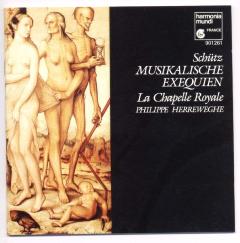Heinrich Schütz - Musikalische Exequien (Herreweghe) [1992]
Heinrich Schütz - Musikalische Exequien (Herreweghe) [1992]

1 I. Concert In Form Einer Teutschen Begräbnis-Messe 25:59 2 II. Motette "Herr, Wenn Ich Nur Dich Habe" 3:39 3 III. Canticum B. Simeonis "Herr, Nun Lässest Du Deinen Diener" 4:55 4 "Also Hat Gott Die Welt Geliebt", SWV 380 (Motet) 3:04 5 "Selig Sind Die Toten", SWV 391 (Motet) 4:21 6 "So Fahr Ich Hin Zu Jesu Christ", SWV 379 (Motet) 3:13 7 "Ich Bin Die Auferstehung", SWV 324 (Petis Concerts Spirituels II) 4:02 8 "O Lieber Herre Gott", BWV 287 (Petits Concert Spirituels I) 3:35 9 "Die Himmel Erzählen", SWV 386 (Motet) 5:01 Agnès Mellon - Soprano Greta de Reyghère - Soprano Monique Zanetti - Soprano Ageet Zweistra - Cello Howard Crook - Alto Jean-Paul Fouchécourt - Tenor Peter Kooij - Bass Hervé Lamy - Tenor Peter Lika - Bass Renaud Machart - Bass Jonathan Cable - Violone Jan Willem Jansen - Orgue Positif Konrad Junghanel – Theorbo La Chapelle Royale Philippe Herreweghe – conductor
Belgian conductor Philippe Herreweghe founded the vocal ensemble La Chapelle Royale in 1977 with a primary focus on music of the French Baroque, but the group has since branched into the repertoires of other countries and eras. In this release, the group sings Heinrich Schütz's three-movement Musikalische Exequien (Musical Funeral Rites) of 1635, as well as several motets. Schütz wrote the Musikalische Exequien for a Protestant nobleman who wanted it to be performed at his funeral. (The German language texts came from Biblical and liturgical texts the nobleman had had inscribed inside his coffin.) The time and places in which Schütz lived were dominated by war, pestilence, and violence, and the composer's personal life was marked by great losses, so it's not surprising that he poured such deep feeling into these texts dealing with death and the hope of a better life hereafter, and the texts he chose for his motets frequently deal with the same subjects. Schütz had been a student of Giovanni Gabrieli's in Venice, and some of the funeral music uses an antiphonal deployment of choirs around the church. The tone of most of the works recorded here is indeed sober and mournful, but the composer's ingenuity gives it variety through his use of differently constituted ensembles alternating with soloists, and the interweaving of monophonic and polyphonic textures. The members of La Chapelle Royale sing with exceptionally pure and warm sound, and the tonal variety and vitality they bring to the motets keep the music from seeming lugubrious, in spite of the dark subject matter. A small ensemble of strings and organ provides a chaste and circumspect continuo accompaniment. --- Stephen Eddins, allmusic.com
download: uploaded yandex 4shared mediafire mega zalivalka filecloudio anonfiles oboom
Last Updated (Sunday, 04 May 2014 09:57)








